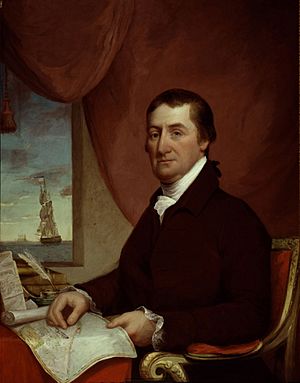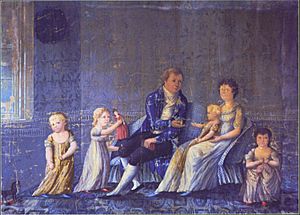Elias Hasket Derby facts for kids
Quick facts for kids
Elias Hasket Derby
|
|
|---|---|

c. 1800–25 portrait by James Frothingham
|
|
| Born | August 16, 1739 Salem, Massachusetts, U.S.
|
| Died | September 8, 1799 Salem, Massachusetts, U.S.
|
| Occupation | Merchant |
| Known for | Owner of the first New England vessel to trade with China |
| Net worth | $800,000 at the time of his death (approximately 1/515th of U.S. GNP, equal to an estimated $11 million in 1996) |
| Spouse(s) | Elizabeth Crowninshield |
Elias Hasket Derby (born August 16, 1739 – died September 8, 1799) was a very rich and famous merchant from Salem, Massachusetts. He lived after the American Revolution. He owned the ship Grand Turk. This ship was the first from New England to trade directly with China.
Contents
Biography
Early Life and Business
Elias Hasket Derby was born in Salem. His father, Richard Derby, was a sea captain and merchant. Elias never went to sea himself. Instead, he started working in his father's business office when he was young. From 1760 until the American Revolution began, he was in charge of keeping the financial records.
By 1760, Richard Derby owned many ships. These ships traded along the coast, in the Caribbean, and across the Atlantic Ocean. The Derby family, like many in Salem, supported the Revolution. They also made money from it. Elias Hasket Derby helped prepare privateer ships. Privateers were private ships allowed to attack enemy ships during wartime. He owned parts of many privateers from Salem.
The Derby family's ship, Grand Turk, was launched in May 1781. It became Salem's biggest and most successful privateer. It captured seventeen enemy ships between 1781 and 1782. Even before the war ended, Elias was doing business on his own. He also worked with his brothers. When peace was declared, people said his fortune was second only to the Cabot family in New England.
The Grand Turk and New Trade Routes
Elias Hasket Derby often worked with privateers. For example, in 1776, he helped Captain Joseph White. This was for a legal case about capturing a British ship called Anna Maria. This ship was full of different goods.
After the war, trade was slow. The privateer ships built during the Revolution were big and fast. Derby helped turn these ships into trading vessels. He started new trade routes with Russia, the Baltic region, and Europe. In 1784, he began trading with the East Indies. Salem became known for its trade with the East Indies. This helped the city become very rich for a while.

In November 1784, Derby sent the Grand Turk to the Cape of Good Hope. This trip was successful. In December 1785, the Grand Turk sailed again to the Cape. The markets there were not as good as expected. So, the ship continued to Mauritius. Mauritius was controlled by France at the time. It had recently opened as a stop for American ships. The Grand Turk was likely the first American ship to visit Mauritius.
The Grand Turk was originally built for privateering. It was very good at this, capturing 25 ships. This brought in a lot of money. The ship weighed 300 tons and was built for speed. It could also carry a lot of cargo. Thomas Barstow built the Grand Turk in May 1781. It was fitted with 28 guns. Derby sent one of his captains, James Gibaut, to watch the building process. The ship was paid for with goods like rum and butter. It was built with the best materials and had a copper bottom.
The merchants in Mauritius offered a new plan. They asked the Grand Turk to take cargo to Canton (in China) and then to Boston. Derby's crew bought a cargo for him in Canton. The Grand Turk was one of five American ships to reach Canton in 1786. It was the first ship from Salem. It returned to Salem on May 22, 1787. This made it the first New England ship to trade directly with China.
Trade with China and India
At first, Derby was hopeful about trade with China. In 1789, there were at least sixteen American ships in Canton. Derby owned four of these ships. However, after 1789, no Salem ship went to Canton until 1797. The market became flooded with tea. Also, the high costs and long journey made profits difficult.
After 1790, Derby stopped sending ships to Canton. Instead, he focused on trade with the Isle of France, Batavia, Sumatra, and India. He also traded a lot with Europe, the West Indies, and Atlantic islands. Between 1786 and 1800, about one-tenth of all American ships visiting Mauritius belonged to Elias Hasket Derby.

In 1787, Elias Hasket Derby sent his son, Hasket (Elias Jr.), to manage the family's eastern trade from Mauritius. In 1788, Hasket traveled to Bombay (in India) with two ships. He bought a cargo of textiles. Hasket continued trading in India until he returned home in 1791. After that, the Derby family became very involved in the India textile trade. They sent at least five ships there over the next four years.
Elias Hasket Derby is sometimes called "King Derby" or America's first millionaire. However, he probably wasn't called "King Derby" during his lifetime. The writer Nathaniel Hawthorne gave him that name in his book The Scarlet Letter. While Derby was very successful, he was one of many rich merchants in Massachusetts at that time.
Family Life
The rich merchant families of Salem often married each other. George Crowninshield married Mary Derby, Elias Hasket Derby's sister. Elias Hasket Derby married Elizabeth Crowninshield, George Crowninshield's sister, in 1761.
Their oldest daughter, Elizabeth, married Captain Nathaniel West. Their marriage ended in a public divorce in 1806. Elizabeth received a large amount of money. She moved to Danvers. There, she inherited a large country house from her father, called Oak Hill. Today, the North Shore Mall is located there. Elizabeth's sister, Anstiss Derby, married merchant Benjamin Pickman. Their son, Hasket Derby Pickman, went to Harvard University. He died the same year he graduated in 1815.
Elias Hasket Derby's father was Richard Derby (1712–1783). Richard's second wife was Sarah Langley Hersey. She was a widow. When Richard Derby died, he left her a large fortune. She used this money to start Derby Academy in Hingham.




